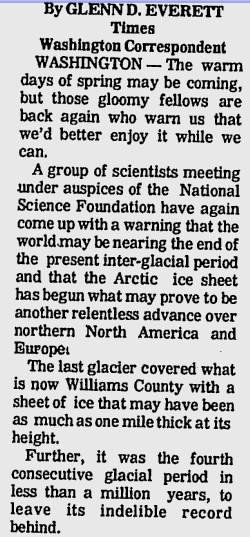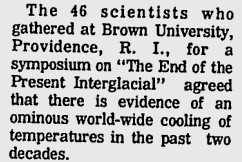Scoundrels at NOAA and NASA have been working tirelessly to rewrite the history of the period, but sadly for them, the Internet never forgets.
Disrupting the Borg is expensive and time consuming!
Google Search
-
Recent Posts
- Fact Checking NASA
- Fact Checking Grok
- Fact Checking The New York Times
- New Visitech Features
- Ice-Free Arctic By 2014
- Debt-Free US Treasury Forecast
- Analyzing Big City Crime (Part 2)
- Analyzing Big City Crime
- UK Migration Caused By Global Warming
- Climate Attribution In Greece
- “Brown: ’50 days to save world'”
- The Catastrophic Influence of Bovine Methane Emissions on Extraterrestrial Climate Patterns
- Posting On X
- Seventeen Years Of Fun
- The Importance Of Good Tools
- Temperature Shifts At Blue Hill, MA
- CO2²
- Time Of Observation Bias
- Climate Scamming For Profit
- Climate Scamming For Profit
- Back To The Future
- “records going back to 1961”
- Analyzing Rainfall At Asheville
- Historical Weather Analysis With Visitech
- “American Summers Are Starting to Feel Like Winter”
Recent Comments
- Bob G on Fact Checking NASA
- Bob G on Fact Checking NASA
- Bob G on Fact Checking NASA
- arn on Fact Checking NASA
- Gordon Vigurs on Fact Checking NASA
- Bob G on Fact Checking NASA
- Bob G on Fact Checking NASA
- arn on Fact Checking NASA
- conrad ziefle on Fact Checking NASA
- conrad ziefle on Fact Checking NASA





Like now it wasn’t real cooling, just all the heat was hiding in th oceans again.
/sarcoff
But Steve, all the little twerps that pop in here and a Anthony’s tell us that it was only a media driven story.
Here you found an article documenting 46 Scientists under NSF. How can that be?
Good find!
We need the book of all these news articles, I tell you! Again.
They have a better duper computer today, so their prophecies are more accurate.
Organizer George Kukla is still with us and unrepentant
http://omnologos.com/whatever-happens-to-old-climate-scientists/
You can see in Shub’s comment how Kukla is still a better scientist than the current lot.
Excerpts from the National Academy of Science’s 1975 summarizing presentation to Congress entitled “Understanding Climatic Change: A Program For Action,” with more than 50 climate scientists contributing:
————————————————
http://archive.org/stream/understandingcli00unit/understandingcli00unit_djvu.txt
While the natural variations of climate have been larger than those that may have been induced by human activities during the past century, the rapidity with which human impacts threaten to grow in the future, and increasingly to disturb the natural course of events, is a matter of concern.
Aside from local climatic effects, such as those due to urbanization, these studies have not yet established the existence of a large-scale anthropogenic climatic impact (Machata, 1973). Like their numerical simulation counterparts, such studies are made more difficult by the high levels of natural climatic variability and by the lack of adequate observational data.
[T]he mechanics of the climatic system is so complex, and our observations of its behavior so incomplete, that at present we do not know what causes any particular climatic change to occur.
What we cannot identify at the present time is how the complete climatic system operates, which are its most critical and sensitive parts, which processes are responsible for its changes, and what are the most likely future climates. In short, while we know something about climate itself, we know very little about climatic change.
From the analysis of the limited data available, we can identify a number of areas in which man’s actions may be capable of altering the course of climatic change. Chief among these is interference with the atmospheric heat balance by increasing the aerosol and particulate loading and increasing the C0 2 content of the atmosphere by industrial and commercial activity. While present evidence indicates that these are not now dominant factors, they may become so in the future.
A striking feature of the instrumental record is the behavior of temperature worldwide. As shown by Mitchell (1970), the average surface air temperature in the northern hemisphere increased from the 1880’s until about 1940 and has been decreasing thereafter. Starr and Oort (1973) have reported that, during the period 1958-1963, the hemisphere’s (mass-weighted) mean temperature decreased by about 0.6 °C. In that period the polar and subtropical arid regions experienced the greatest cooling. The cause of this variation is not known, although clearly this trend cannot continue indefinitely… The well-documented warming trend of global climate beginning in the 1880’s and continuing until the 1940’s is a continuation of the warming trend that terminated the Little Ice Age. Since the 1940’s, mean temperatures have declined and are now nearly halfway back to the 1880 levels.
One may still ask the question: When will the present interglacial end? Few paleoclimatologists would dispute that the prominent warm periods (or interglacials) that have followed each of the terminations of the major glaciations have had durations of 10,000 ±2000 years. In each case, a period of considerably colder climate has followed immediately after the interglacial interval. Since about 10,000 years has elapsed since the onset of the present period of prominent warmth, the question naturally arises as to whether we are indeed on the brink of a period of colder climate. Kukla and Matthews (1972) have already called attention to such a possibility. There seems little doubt that the present period of unusual warmth will eventually give way to a time of colder climate, but there is no consensus with regard to either the magnitude or rapidity of the transition. The onset of this climatic decline could be several thousand years in the future,although there is a finite probability that a serious worldwide cooling could befall the earth within the next hundred years.
The question remains unresolved. If the end of the interglacial is episodic in character, we are moving toward a rather sudden climatic change of unknown timing, although as each 100 years passes, we have perhaps a 5 percent greater chance of encountering its onset.